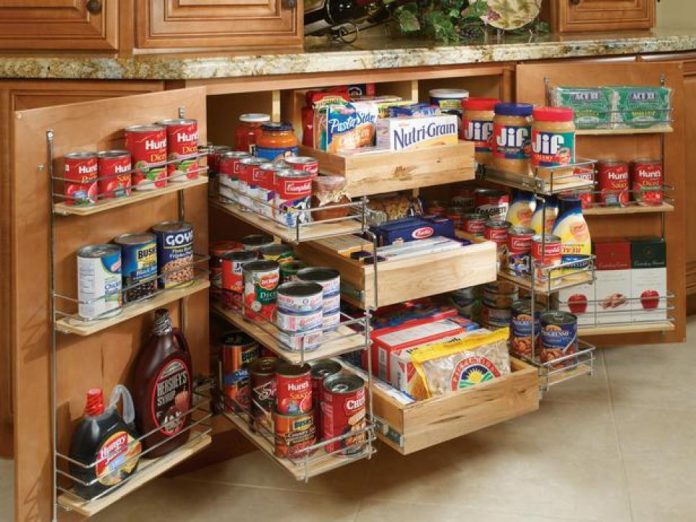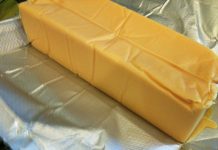Anyone who knows something about prepping knows that a large part of prepping is building a survival pantry or stockpile. This is where we started for most of us, and no matter how long we’ve been at it, we’re possibly always adding it to it. At times, this can create issues, both when trying to find places to put all the food in and trying to keep track of what we have in our pantry.
As someone who has had trouble locating anything will tell you, it’s just about as difficult as not getting it at all to not be able to find it. You can not know what you have when push comes to shove and you may not really have time to go looking for it. It is important that your stockpile is well organized and easy to work with.
However, that does not eliminate the need to break up your stockpile. The threat of a home invasion is still there, so you need to have your food broken up and stored in various parts of your home. That only adds to the challenge of making your pantry usable by organizing it.
There are always things you can do to make your pantry better. And you should also constantly enhance it, just like continuously adding to it. It would certainly make it easier for you to take the time to do these stuff now, when the time comes for you to really eat the food in your pantry.
Related: Prepping on a Budget – How To Get Survival Supplies When You Have Almost No Money
Develop a Printed Inventory
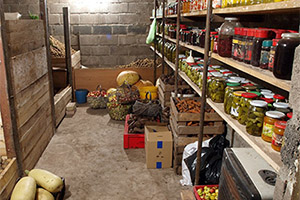

It is a smart idea to take the moment and create a written list of what you have in your pantry and put it in a notebook. But don’t just put amounts of items; write down where you’ve stashed away every one of those objects.
You’ll split up each object if you do it correctly, so you’ll need to remember every place you put it in, as well as how much you have in that area.
If you do this, the first thing you’ll find is that you have more things than you thought you were doing, and fewer things than others. And the first advantage that you’re going to get out of your inventory is an opportunity to fix those shortages. Make sure that when you put the new things away, you change your count, so that your inventory stays correct.
That inventory can assist you with meal preparation when the time comes, as well as discovering where you put it, saving time and hassles. Just make sure that, when you use items, you refresh the inventory so that you always have an accurate count of what you have.
Building a Survival Recipe Book
Talking about your inventory, do you have recipes that you can cook with that food? Fortunately, the majority of people I’m talking to don’t. They just think they can cook everything they’ve got. But you’re going to have to do some actual cooking unless your stockpile is made up of only canned goods. Not only that, but you cook over a fire, not the way you used to.
Either you’re going to need entirely new recipes than you’re used to, or you’re going to find ways to change the recipes you’re using, in order to cook them with the techniques and foods you’re going to have available to you. It would be a good idea to try those changes now, just to be sure that when your supplies are low, they will work, without wasting food.
In addition to that, in order to get your family to eat them, there is a fair chance that you’ll have to doctor up some dishes, adding spices to them. Once again, while it doesn’t hurt you to throw away food that doesn’t turn out right, it’s easier to find it out now than to wait until you can’t afford to throw it away.
Related: Sealed Foods that Last Forever
Automatic Stock Rotators for Canned Goods
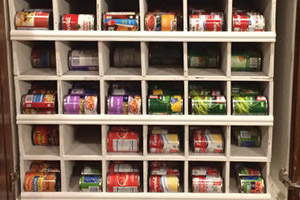

For your prepping pantry, there are two underlying philosophies; either maintaining an inventory of food that is separate from your normal pantry and stays undisturbed until a crisis, or combining your prepping stock with your everyday food intake and rotating your food stock.
If you can, rotating your stock is a smart idea. But it can be a major hassle to rotate your stock, forcing you to clear your shelves so that you can put the new products back in the older ones. The easy solution to this is to build racks that allow you, without having to move the old, to place the new inventory behind the old.
Building racks so the cans can roll down is the easy way to do this, particularly with canned goods. I’ve seen a variety of different setups, from those that hang on the wall to whole racks that can accommodate hundreds of food styles.
Regardless of how physically equipped they are, from the back or top, you load the new cans into the rack, and those cans roll down the track until they reach the current stock. You do that from the front of the rack when you need to take a can, where the oldest can automatically be.
It is also possible to use the same concept for packaged products, but that is not quite so simple. But doing so with canned items would help ensure that while you are continually replacing the old food with new, your food stockpile is as fresh as possible.
Related: 59 Long-Term Survival Foods and Supplies from the Grocery Store
Underbed Storage
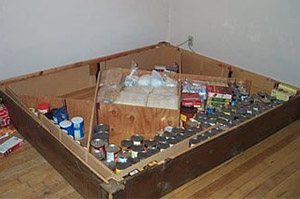

Underneath the beds is one of the least used storage areas in most households. Although there is something hidden under the bed for most people, it’s not much, not well organized and definitely not taking up all the room available.
The fact that box springs no longer exist is what makes this much worse. Literally, if you buy a mattress and a “box” now, that’s what you get; a box. Look at the bottom of this post, and you’ll see it’s bare. All the room will be lost.
All you need to do is build a box that will take up the room underneath the bed and the box springs that are now empty. It can either cover the current bed frame or it can be mounted just inside the frame if you have a fancy bed frame. To keep it up, place a hinged framework on top of it, with the hinge at the head of the bed and some prop rods. Then fill up the food room, making sure you annotate what’s in your inventory.
Putting In a Water Cistern
The toughest thing to stockpile is probably water, mainly because we need so much of it. It’s hard to find enough space to bring enough water into your home to last very long. One answer may be to fill your basement with blue plastic barrels, but most of us need that space for other stuff as well.
With a swimming pool, one of the easiest ways to store a lot of water is for a few hundred bucks, you can purchase a good above-ground pool. This will allow you to store a lot of water without taking up space for other items that you need. Not just that, also taking care of the pool and constantly applying chlorine would keep the water clean and safe to drink. Your neighbors are not even going to know it’s a cistern.
So, how much water can you store in a pool that is above ground? That depends on the pool’s size. A 12-foot pool, 30 inches deep, can accommodate approximately 2,100 gallons of water. 4,500 gallons can accommodate one that is 16 feet in diameter and three feet wide.
Related: 5 Water Storage Myths
You Need Some Survival Caches
For any prepping pantry, one of the most crucial and frequently ignored needs is to provide remote food caches for use in an emergency. When their town burned to the ground in November of 2018, every prepper living in Paradise, California lost their entire stockpile. While the town was evacuated and the residents were safe, I’m sure some of them were low on cash and wished they had some food stashed away somewhere in a cache.
It is possible to find remote survival caches near or far, just as long as they are in locations that make sense for your overall survival strategy. Instead of only one large one, it is easier to have many of them. Although getting food in the middle of a crisis may be a hassle, having it located away from your home could also be just the thing that helps you survive.
There are several ways to create a cache, like storing food in houses for relatives and friends, or renting a small “mini-warehouse” storage. Food may also be buried underground. For this, five-gallon buckets are perfect, as they are humidity-proof and strong enough that rodents and insects will not eat their way through. Just make sure that you choose good landmarks for everything you bury, so that you can locate it again.



